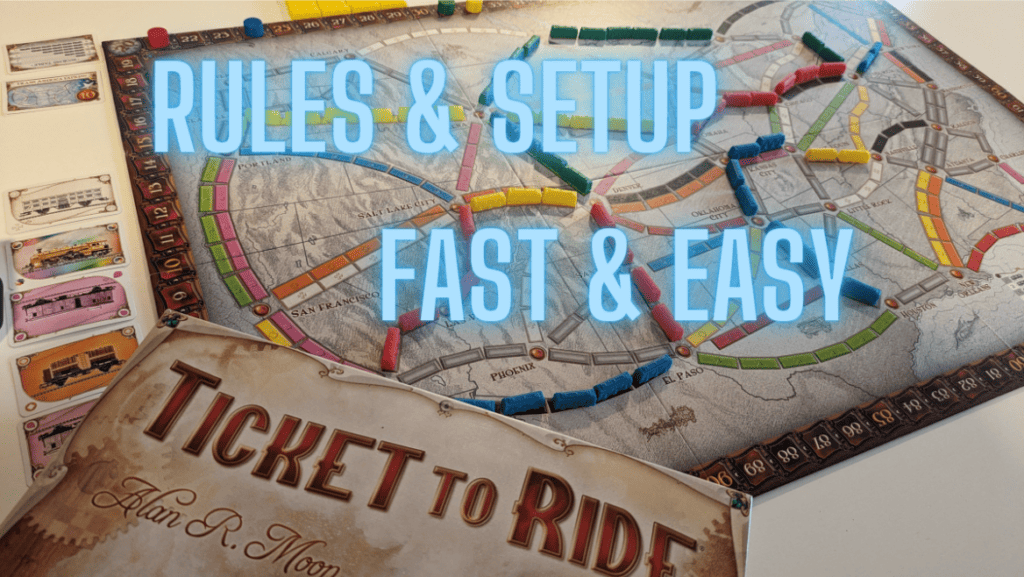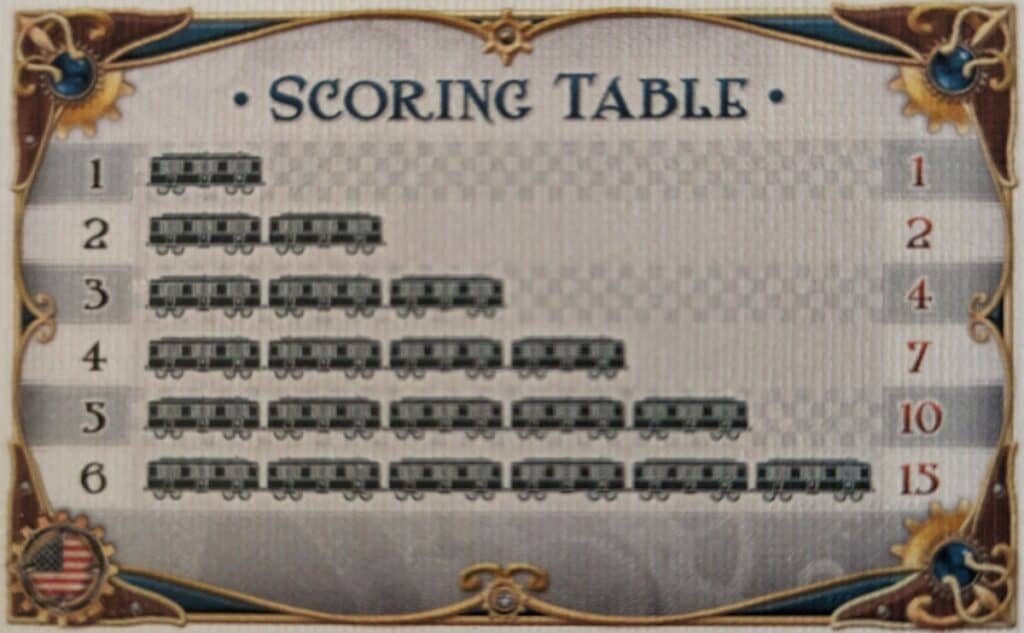
The rules and instructions for Ticket to Ride can be daunting, to say the least, so here is everything you need to know to set up the game and get playing quickly. If you prefer a video explanation, I have that for you, too. A PDF of the official game rules can be found here, but my condensed version below is more to the point and easier to understand. Have fun!
Ticket to Ride Setup

- Place the board in the center of the table
- Distribute a set of 45 colored train cars to each player
- Place a matching colored scoring marker for each player next to the ‘Start’ along the map border
- Shuffle the Train Cards and deal 4 to each player, face down. A player may look at their cards.
- Place the deck of remaining Train Cards face down next to the board.
- Turn 5 cards face up from the Train Card deck and place them next to the board.
- Shuffle the Destination Cards and deal 3 to each player, face down. A player may look at their cards.
- Each player must keep at least 2 Destination card but may keep all 3. Discard the rest.
- Place the deck of remaining Destination Cards in a pile face down next to the board.
Ticket to Ride Objective
The object of Ticket to Ride is to score the most points by the end of the game. Points are scored in three ways:
- Connecting routes between adjacent cities
- Completing a continuous path of routes between cities listed on Destination Ticket Cards
- Creating the longest continuous path of train cars
Points are deducted for incomplete routes listed on a player’s Destination Ticket Cards.
Taking a Game Turn
The player with the most travel experience goes first, and play proceeds clockwise around the table. On a player’s turn, he or she must perform one (and only one) of three actions:
Draw Train Car Cards
A player may draw 2 Train Car Cards and add them to their hand. The player may draw a face-up card or make a blind draw from the deck. If the player draws a face-up card, immediately replace it by turning a card face-up from the deck. Then, the player may draw a second card from the face-up cards or from the deck, as before.
- There are 8 different colors that correspond to different colored routes on the board
- Locomotives are ‘Wild’ and may be played with sets of matching Train Car Cards
- There is no limit to how many Train Car Cards a player may hold in their hand
- If 3 Locomotive cards are ever shown face-up in the group of 5 draw cards, discard all 5 card and replace them with new ones
Locomotives: If a player draws a Locomotive (a Wild Train Car Card) from the face-up cards, their turn is complete. If a player has already drawn a Train Car card, they cannot draw a Locomotive from the face-up cards. It takes the equivalent of two draws to draw a Locomotive from the face-up cards. If a player draws a Locomotive blind from the deck, they may draw a second card.
Claim a Route on the Map
A player may claim a route on the board by playing a set of Train Car Cards that match the length and color of the route into the discard pile, and then placing their trains on each space of the route. The player then records their score by moving their scoring token along the track on the edge of the board.
Scoring a route depends on its length. Consult the Scoring Table on the board (also shown here).

The cards played to claim a route must all be of the same type/color, with the exception of Locomotives which are ‘Wild’ and can be substituted for any color.
A player may claim any open route on the board, except on Double-Routes. One player cannot claim both routes that directly connect two cities.
Note: In 2- or 3-player games, Double-Routes should be treated as Single-Routes. Only one of the two routes may be used.
Draw Destination Ticket Cards
A player draws 3 Destination Ticket Cards from the top of the deck. The player must keep at least 1 of the new cards but may choose to keep 2 or all 3. The player then discards any cards they do not wish to keep and ends their turn.
Ending the Game & Final Scoring
When one player is left with only 2, 1, or 0 trains in their stock, each player (including that player) gets one final turn. The game then ends and all players calculate their final scores.
Players should have kept track of their scores from completed routes throughout the game by moving their scoring token along the edge of the board as the routes were completed, but re-checking for accuracy is permitted and encouraged.
Players then reveal their Destination Ticket Cards. If the cities are connected by their trains (it does not have to be the most direct route) then they add the number of points shown on the card to their score. If the cities are not connected, that amount of points is deducted from their score.
The player who has the longest continuous path of train cars scores an additional 10 points. This path may pass through the same city more than once and can include loops, but cannot count the same train car twice. In the case of a tie, all tied players get 10 points.
The player with the most points wins. If the score is tied, the player who completed the most Destination Ticket Cards wins. If it is still tied, the player with the longest continuous path of trains wins.
Frequently Asked Questions
What are the best Ticket to Ride strategies?
Generally, the best Ticket to Ride strategies are accumulating many Train cards from the draw pile, keeping long, well-coordinated Destination cards, and playing many trains on consecutive turns. You should also obstruct your opponents’ routes and try to claim important bottlenecks early on.
I have written a complete, in-depth guide about the best Ticket to Ride strategies here where I go into great detail about the most proven ways to win.
How many players can play Ticket to Ride?
Ticket to Ride is for 2 to 5 players. With 2 players, ‘double routes’ can only be claimed by 1 player. With 3 or more players, both routes in a double route can be claimed, but the same player cannot own both routes.
What ages can play Ticket to Ride?
Ticket to Ride is designed for players aged 8 and up. I have found that this age recommendation is about right. My 9-year-old daughter enjoys playing the game now, but she didn’t have the attention span for it when she was younger.
How long does a game of Ticket to Ride last?
The makers of Ticket to Ride (Days of Wonder) state that a game typically lasts about 30 to 60 minutes. In my experience, games usually run closer to the lower end of that estimate but it will depend on how quickly the players in your group play.
What happens if we run out of Train Car Cards or Destination Ticket Cards?
If you run out of Train Car cards or Destination Ticket cards, simply reshuffle them and place them back next to the table to be reused. Make sure to thoroughly mix and shuffle the Train Car cards since they were turned in in groups of the same color.
How many cards are players dealt to start the game?
At the beginning of Ticket to Ride, deal 4 Train Car cards and 3 Destination Ticket cards to each player. Players may discard up to 2 Destination Ticket cards if they so chose.
How many trains does each player have?
Each player begins Ticket to Ride with 45 trains. The game comes with 3 spare trains in each color in case any trains are lost.
